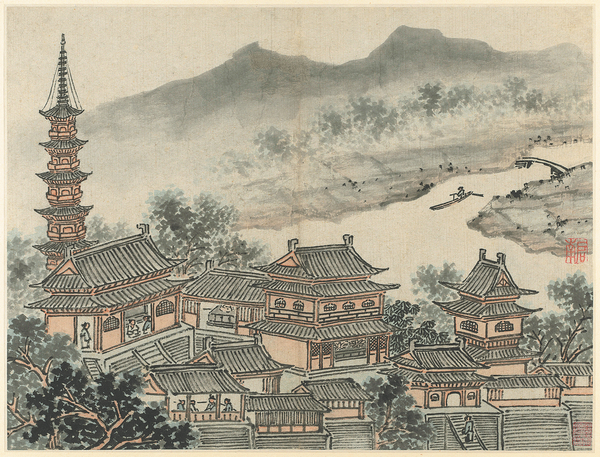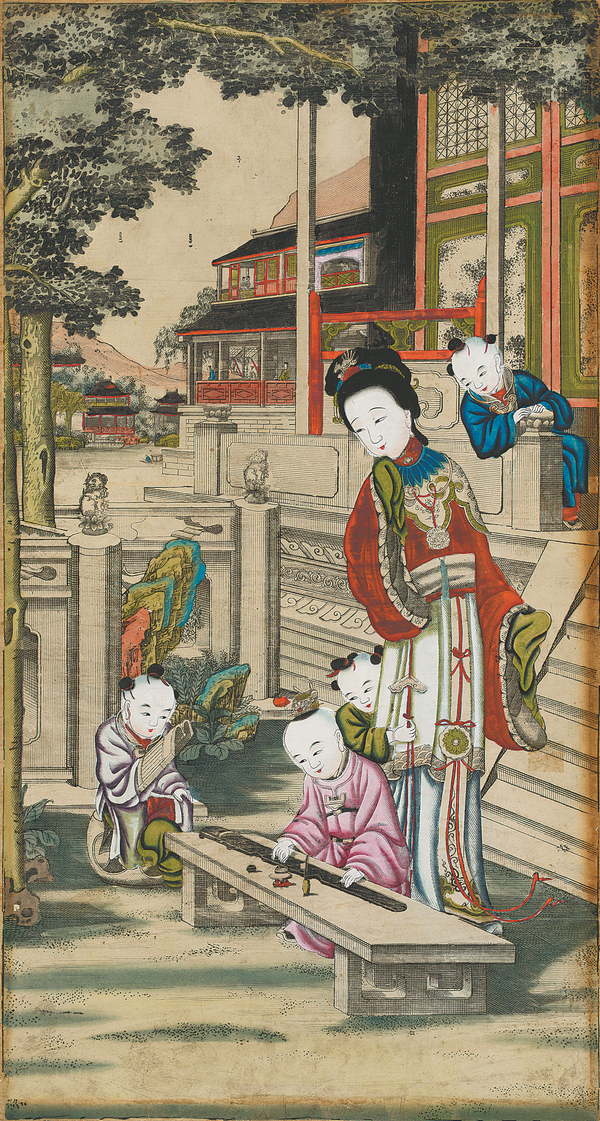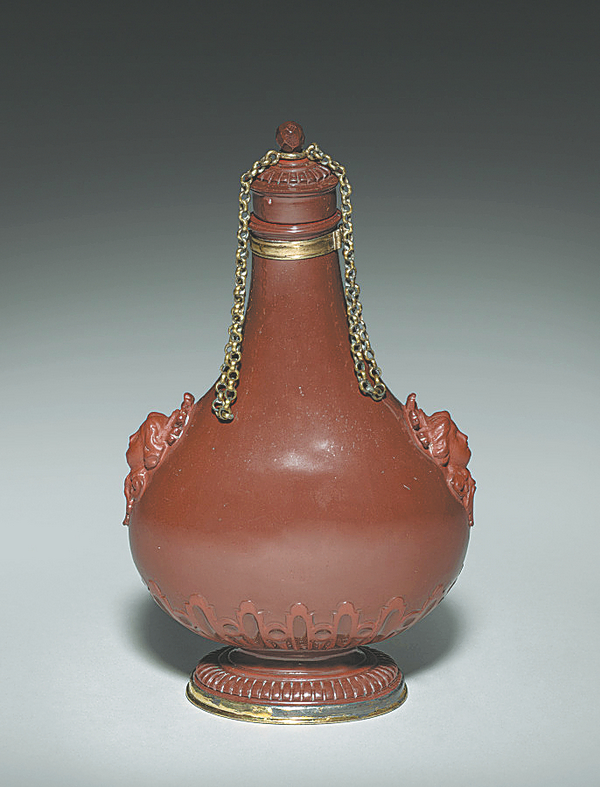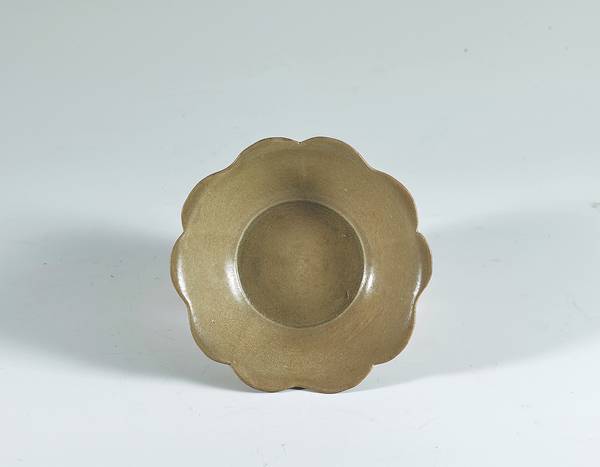The embodiment of beauty

A leaf from Shen Zhou's painted album showing a signature view of Jiangnan is curator Clarissa von Spee's choice for the cover of catalog of the exhibition China's Southern Paradise: Treasures From the Lower Yangzi Delta, at the Cleveland Museum of Art. CHINA DAILY
As a melting-pot of ideas, beliefs and stunning landscapes, Jiangnan became the window through which the world viewed China, Zhao Xu reports.
Of all the 240 items at the current exhibition China's Southern Paradise: Treasures From the Lower Yangzi Delta, at the Cleveland Museum of Art, Clarissa von Spee, the curator, has singled out one particular painting as the cover of its accompanying catalog.
"Why this one? Because it represents China and Cleveland," says Spee, noting that the piece, a leaf from a painted album by the much-celebrated 15th-century painter-calligrapher Shen Zhou, is often requested for viewing by visiting scholars drawn to the museum's enviable Chinese art collection.
"It shows water, it shows a misty landscape, it shows Buddhist temples and a pagoda, which together constitute the ultimate image of China for a Westerner living before our modern age," says the curator, who believes that her visitors will "not only see Chinese art, but will see China through art".
It's an ambitious goal Spee sought to accomplish by focusing the entire show on one specific area of China — Jiangnan, meaning "land south of the Yangtze River". Originally a terrain of wilderness to which dismissed officials were exiled, Jiangnan, throughout Chinese history, managed to reinvent itself again and again, until it became what Chinese dubbed "the land of fish and rice", marked by equally rich agricultural and artistic productions, and by extensive trade that linked it to the world beyond.
Spee's storytelling started with the ancient cultures of Hemudu (5000 BC-3300 BC) and Liangzhu (3300 BC-2300 BC), the influence of both were concentrated on the Yangtze River Delta in southeastern China, the region that would eventually become known as "Jiangnan". Although the earliest remains of silk were found in central China, silkworms depicted on Neolithic ivory and pottery from Hemudu suggest their early domestication in the south. That narrative thread would be later spun into resplendent silk to be exported to foreign markets, with Jiangnan being its indisputable center of production between the 14th and early 20th centuries.

A print likely produced in the Jiangnan city of Suzhou. CHINA DAILY
Appreciating contrast
First to recognize the potential of Jiangnan, the people of Liangzhu, in around 3000 BC, built a grand city of 100 million square meters on its swampy marshland, before spreading their splendid jade culture inland through the area's crisscrossing waterways. Drawing everything from giant wood to raw jade from the mountains that surrounded the ancient city on three sides, these people seemed to have little use of the sea to its east.
Yet three millennia after the demise of Liangzhu, believed to have been partly caused by repeated inundation of its paddy fields by marine floodwater, that same sea would carry ships loaded with the Tang (618-907) empire's prized green stoneware to many parts of the world. Known in the West as celadon, these wares were produced by the famed kilns in Jiangnan, and contained a soft jade-green hue "taken from the verdant mountains (of Jiangnan)", to quote a contemporary author.
In the meantime, novice monks from Japan and Korea were treading the waters to Jiangnan, where, taught in monasteries by Buddhist masters, they were getting an education that was not only religious, but also literary and aesthetic.
"They were pilgrims to sites steeped in history and imbued with the mood of Chan (Zen in Japanese) Buddhism," says Spee, whose point is amply illustrated by the many long painted scrolls laid out at the exhibition, each capturing a horizontal slice of the mist-shrouded, water-saturated Jiangnan riverscape.
One of them, awash with monochrome ink, depicts mountains, lush in vegetation, emerging from a lacework of streams. On loan from the Tokyo National Museum, it was created by the 11th-century painter Li Gonglin and was meant for a Chan master who had traveled widely before arriving at a temple in Jiangnan.
"The hazy atmosphere can be read as Chan Buddhism's belief in the illusory nature of reality: Nothing is real but the Buddhist truth," she says.
Inside the monasteries, enlightenment could also be gained by gazing intently at a spartan-looking Jianyao tea bowl and "learning to appreciate the contrast between the black glaze and the white froth produced as the tea powder was whisked vigorously", to use Spee's words. (The fact that Jianyao sites — yao means kilns — were located outside the Jiangnan area, in the Chinese province of Fujian further south, has allowed the curator to highlight Jiangnan's role in serving up an abundance of beauty that China has to offer.)
"All these ideas of beauty and nature, they took with them to Japan and Korea and made them their own," says Spee. She is pointing to the influence of the Jiangnan landscape on Japanese painters of the Edo period (1603-1868), and to the continued treasuring of the Jianyao bowls in Japan, where they became known as tenmoku (tianmu in Chinese) bowls, after Tianmu Mountain in Hangzhou.
One of the best-known Jiangnan cities, Hangzhou was the capital of China's Southern Song Dynasty (1127-1279), whose territory was mainly composed of the Jiangnan region and whose emperors were, almost without exception, master calligraphers and devoted Buddhists who ruled, not unlike their ancestors, in accordance with the teachings of Confucianism.
"What these visitors to Jiangnan learned was that one can be a Taoist, Buddhist and Confucian at the same time, that the Chinese were able to tolerate several ideological currents and philosophies, and live them," says Spee.
And they kept coming well into the 14th century, as attested by a piece of calligraphy from the Chinese Chan master Chushi Fanqi (1296-1370), on display at the exhibition. In it, Fanqi, venerated in Japan as Soseki Bonki, dedicated a poem to one of his departing Japanese friends who "has long served as an attendant to great (Buddhist) masters here", and whose thoughts "are now with the ship Japan-bound".
With all that being said, not many had journeyed to China in the pre-modern era. For those who didn't make the trip, glimpses of that faraway place could be gained from what was available in the local markets.
"By the 10th century, celadon wares produced exclusively by the kilns in Jiangnan had become China's biggest export," says Chen Jie from the Shanghai Museum, which contributed 14 exhibits to the exhibition, including porcelain wares produced between the 7th and 18th centuries.
"A late 9th-to-10th century shipwreck discovered in 2003 in the Java Sea offshore of Cirebon, Indonesia, contained more than 200,000 celadon items," she says, adding that the discovery is only one of the three made since mid-1990s in the area of the Java Sea frequented by 9th-to-10th century merchant vessels loaded with large amounts of Chinese porcelain.
While scholars are still arguing over whether Southeast Asia had served as a crucial waypoint for China's maritime porcelain trade, it is widely agreed that the celadon wares were exported as far as central Africa and southern Europe.

A "pilgrimage bottle" produced by Europe's first porcelain factory in Meissen, Germany. CHINA DAILY
Held captive
Items that stand testimony to the influence of Chinese porcelain are included in the exhibition. Produced around 1780, a round box with a lid from a German museum dedicated to lacquer art features a light green cracked lacquer application on top of paper mache base. It was meant to imitate the cracked glaze of Guanyao ware (Guan is the name of the kilns), a special type of celadon developed in Hangzhou during the Song era.
Some seven decades earlier, a German named Johann Friedrich Bottger and his collaborator cracked the porcelain code for their countrymen, before setting up Europe's first porcelain factory in Meissen, Germany. The exhibition put on display a red stoneware item produced by the factory in 1715, which Spee believes was clearly inspired by the brownish-red colored teapots from the Jiangnan city of Yixing. The latter was commonly exported to Europe from the 17th century onward.
Interestingly, the Meissen product took the shape of a "pilgrimage bottle", the origin of which can be traced to both the ancient Roman times and to the 7th-century China, where they were often carried by those who had arrived at their final destination via the ancient Silk Road. Equally interesting is the fact that Bottger, thanks to his talent as an alchemist, was once held captive by his king August the Strong, Elector of Saxony in Germany, who had within his much-treasured porcelain collection dozens of Yixing teapots.
The king was far from the only one intrigued by China. When pictures of tilling and weaving — so often created that it became a genre of its own starting from the time of the Southern Song — ended up in the Palace of Versailles in the 17th century, it "triggered a discussion in France as to whether agriculture was the foundation of a good, functioning state", to quote Spee.
"To the people of the court, China looked like a very well governed country," she says.
That message was further spread through printmaking. The exhibition includes two etchings on paper created in 1775 by English engraver John June that were based on the drawings of the German draftsman Augustine Heckel, who, in turn, based his work on a Chinese painting of tilling and weaving.
The phenomenon would have bemused the Chinese emperors, who had actively promoted the theme as a way of saying that they cared deeply about the well-being of their subjects and the fortunes of their states. Yet the images contained too much truth to be mere political statements.

With verdant mountains and paddy fields, this 17th-century painting (partially shown above) depicts Jiangnan as paradise on earth. CHINA DAILY
Jiangnan, by virtue of being located south of the Yangtze River, had, throughout Chinese history, repeatedly served as safe haven for those fleeing China's war-torn north. Carrying with them their own beliefs and customs, this immigrant population joined with the locals to make Jiangnan the wealthiest and most fertile land, a kaleidoscopic existence showcasing a condensed version of Chinese history, art and culture.
Here comes one of Spee's central tenets. "When people in the West saw these images of tilling and weaving, of temples, pagodas and beautiful women teaching their children, they weren't aware that these came from Jiangnan. Instead, they equated them with China," she says.
Among other things, Spee is also referring to the colored woodblock prints once made in large quantities in the Jiangnan city of Suzhou. Despite not being made for export, they nonetheless reached Europe, where they survived in castles as wall paper, presumably fulfilling an imagined perception of the Oriental country.
However, the curator believes that China, as introduced to the West through imported Chinese art, should be clearly differentiated from the China dreamed up by Western artists and craftsmen who were behind the decorative style of Chinoiserie, literally meaning "China Style".
While the latter was fueled by a vague curiosity which led to the adoption of new forms and motifs, which often amounted to fantasized versions of reality, the former, says Spee, was built upon "a serious interest" that was maintained through "consistent exchange between China and Europe", and was reciprocated.
"They both admired each other for certain things," says Spee, who made a point of displaying the likenesses of two rulers from China's Qing Dynasty — Emperor Kangxi (1654-1722) and his grandson Emperor Qianlong (1711-99). Both were known for making grand inspection tours to Jiangnan — six times for each — that helped to "bring the region to its heights".
And both welcomed Jesuit missionaries to China, and to their respective courts. While the portrait of Kangxi was painted by an anonymous Chinese painter who had clearly adopted the Western technique of shading, the one for Qianlong was done by Jesuit missionary and artist Giuseppe Castiglione, who arrived in China in 1715 and never left.
In 1766, the year of Castiglione's passing, Qianlong was presented with six French tapestries. Intrigued, he commissioned tapestries in the French style from workshops in Suzhou. One of the results, on display at the exhibition, depicts a typical Chinese family gathering on New Year's morning, rendered using Western perspective and shading, and complete with a woven Western picture frame.

A celadon ware from the Tang Dynasty (618-907). CHINA DAILY
Virtual discussions
Spee visited Jiangnan for the first time in 1999, to conduct research on a 20th-century art connoisseur from the region. This was followed by a 2015 fellowship at the China Academy of Art in Hangzhou, the former capital of the Southern Song era. Realizing the immense cultural influence of the region, Spee came up with the idea for the current exhibition, which eventually ended up taking her eight years to prepare.
Help was enlisted worldwide, including from seven Chinese museums and cultural institutions that have lent exhibits to the show under the auspices of Art Exhibitions China, a governmental body tasked with promoting Chinese cultural heritage overseas.
"A lot of work was carried out during the pandemic through online discussions, and nothing would have been accomplished without the huge amount of trust each side placed in the other," says Shi Wanghuan from AEC, which, back in 1973, took some of China's most prized archaeological finds to the United States for a groundbreaking exhibition, the first since the founding of the People's Republic of China in 1949.
"The director of Beijing's Palace Museum, which contributed to the show, said that when the relationship between the US and China is strained, it's important that we maintain cultural exchanges, to counter the tension and balance it out through art," recalls Spee.
In one of his books partly tracing the history of the European obsession with Chinese porcelain, British ceramist Edmund de Waal wrote: "I want poems that compare white porcelain to smoke coiling up from a chimney, or from incense on an altar, or mist from a valley, or, at the very least, an egret in a paddy field poised."
For those who have entered the world of Jiangnan upon Spee's invitation, that incense could have been burning on the altar of a Buddhist temple; that mist, cloaking Shen Zhou's landscape; and that egret, an exclamation point to the serene beauty of Jiangnan to which, says the curator, "every human being would respond".
Related articles
-
 Exhibition is picture of success
Exhibition is picture of successMore
-
 A Window to Beijing's Spirit
A Window to Beijing's SpiritMore
-
 An Odyssey between Past and Present——The Observation of Chinese Calligraphy and Sculpture in Real Li
An Odyssey between Past and Present——The Observation of Chinese Calligraphy and Sculpture in Real LiMore
-
 A Chinese painter dedicated to cross-cultural communication through art
A Chinese painter dedicated to cross-cultural communication through artMore
-
 Artist with a bird's eye view
Artist with a bird's eye viewMore
-
 Pictures worth a thousand words
Pictures worth a thousand wordsMore
